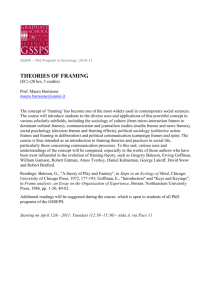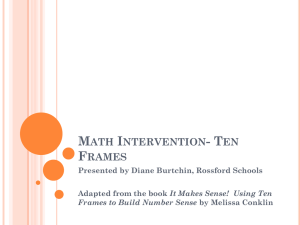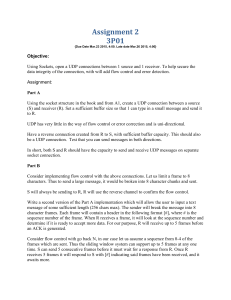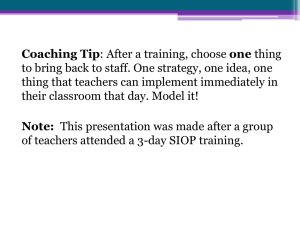Framing A Message: How to Think About Communications
advertisement
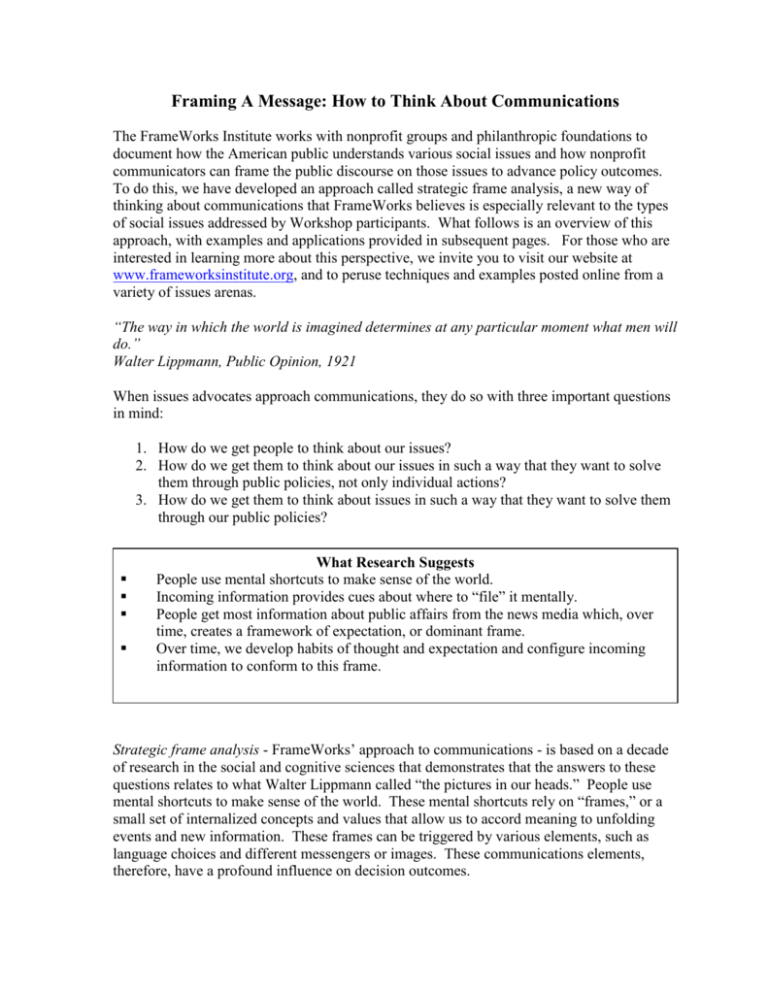
Framing A Message: How to Think About Communications The FrameWorks Institute works with nonprofit groups and philanthropic foundations to document how the American public understands various social issues and how nonprofit communicators can frame the public discourse on those issues to advance policy outcomes. To do this, we have developed an approach called strategic frame analysis, a new way of thinking about communications that FrameWorks believes is especially relevant to the types of social issues addressed by Workshop participants. What follows is an overview of this approach, with examples and applications provided in subsequent pages. For those who are interested in learning more about this perspective, we invite you to visit our website at www.frameworksinstitute.org, and to peruse techniques and examples posted online from a variety of issues arenas. “The way in which the world is imagined determines at any particular moment what men will do.” Walter Lippmann, Public Opinion, 1921 When issues advocates approach communications, they do so with three important questions in mind: 1. How do we get people to think about our issues? 2. How do we get them to think about our issues in such a way that they want to solve them through public policies, not only individual actions? 3. How do we get them to think about issues in such a way that they want to solve them through our public policies? What Research Suggests People use mental shortcuts to make sense of the world. Incoming information provides cues about where to “file” it mentally. People get most information about public affairs from the news media which, over time, creates a framework of expectation, or dominant frame. Over time, we develop habits of thought and expectation and configure incoming information to conform to this frame. Strategic frame analysis - FrameWorks’ approach to communications - is based on a decade of research in the social and cognitive sciences that demonstrates that the answers to these questions relates to what Walter Lippmann called “the pictures in our heads.” People use mental shortcuts to make sense of the world. These mental shortcuts rely on “frames,” or a small set of internalized concepts and values that allow us to accord meaning to unfolding events and new information. These frames can be triggered by various elements, such as language choices and different messengers or images. These communications elements, therefore, have a profound influence on decision outcomes. Frames are existing constructs that allow us to interpret developing events.. William Raspberry, writing in the Washington Post, explains the power of frames when he says, “Perhaps the only way we can assimilate new information is by fitting it into the framework of something we already understand.” He goes on to explore the meaning of terrorism “by thinking about America and black people.” And, in so doing, he demonstrates the way our judgments about political issues can be influenced by the frame we use to make sense of new situations. Thinking about the Civil Rights Movement, Raspberry writes: “When we saw it as a choice between civil progress and bloodshed, our minds went one way. When we saw the choice as between siding with brutal law enforcement and siding with black folk demanding change, our minds went the other way.” Raspberry has elegantly illuminated the framing process that is so critical, if invisible, to political judgment. What Is A Frame? “Frames are organizing principles that are socially shared and persistent over time, that work symbolically to meaningfully structure the social world.” Stephen D. Reese, Framing Public Life, 2001 Where do people get their frames of public affairs? “Most people don’t think about most issues most of the time,” write Nelson Polsby and Aaron Wildavsky in a famous analysis of American public opinion. The public has little daily contact with many issues on the public agenda, yet their opinions greatly influence policymaker priorities and behavior. Traditionally, news media is the main source of Americans’ information about public affairs. In this way, the media dramatically influences what issues the public and their policymakers will address. Moreover, messages conveyed by mainstream media take on the value of public narratives about the ways of the world. Thus, media doesn’t simply tell us what to think about, it tells us how to think about issues. News coverage influences: What issues people think are important for government to address (agenda-setting) The lens through which people interpret issues (framing), and What information will prove relevant for social and political judgments (priming). Our research on young adults/teens, for example, included an investigation of how the news media covered the issue. But this analysis sought not only to chart the volume of coverage to see if teens figured on the national agenda, but also to isolate the way the media was framing the issue, or how it was telling the “teens” story. We looked for explanations of cause, not merely effect, and for the inclusion of solutions and policy debates in the coverage. We do so because we know that different kinds of frames have different kinds of effects on public opinion. “The use of either the episodic or the thematic news frame affects how individuals assign responsibility for political issues; episodic framing tends to elicit individualistic rather than societal attributions of responsibility while thematic framing has the opposite effect. Since television news is heavily episodic, its effect is generally to induce attributions of responsibility to individual victims or perpetrators rather than to broad social forces.” Shanto Iyengar, Is Anyone Responsible?, 1991 The episodic frame presents a portrait, while the thematic frame pulls the camera back to present a landscape. The importance of this distinction is that the two types of frames have very different effects on how people view a given problem--and whether people will see the need for individual-level and/or broader environmental or institutional solutions to that problem. Episodic frames reduce life to a series of disconnected episodes, random events or case studies. “Betty Jones and her family of four are braving the elements tonight because the homeless shelter was full,” begins an episodic story on the homeless. Such a news story might go on to describe how the children miss their toys, how cold it is, when they last ate, etc. What it will not describe is how many people are homeless in this city, whether the numbers are increasing or decreasing, or the root causes of homelessness. In contrast, thematic frames provide details about trends, not just individuals; they identify shortcomings at the community or systems-level that have contributed to the problem. “The homeless shelter at 4th and Q was full again tonight because of drastic reductions in city allocations, and this situation is taking its toll on families like Betty Jones’. But the mayor says the Jones family will have to brave it because there is no more money in the city to pay .....” The more episodically social issues are framed, the less likely it is that citizens will hold government accountable for solving the problem. The more thematic and contextual the coverage, the more likely it is that citizens will see the issue as one appropriate to government resolution. The media’s influence on how we think about social problems lasts far beyond our memory of a particular newscast or news topic. The way the news is “framed” on many issues sets up habits of thought and expectation that, over time, are so powerful that they serve to configure new information to conform to this frame. When advocacy groups communicate to their members and potential adherents, they have options to repeat or break these dominant frames of discourse. Understanding which frames serve to advance which policy options with which groups becomes central to any movement’s strategy. The literature of social movements suggests that the prudent choice of frames, and the ability to effectively contest the opposition’s frames, lie at the heart of successful policy advocacy. Most movements are associated with the development of an innovative master frame which will either constrain or inspire that movements future development. If “brushing teeth” or “dental care” are not effective master frames, capable of growing beyond the immediate policy needs of the movement, they will constrain later developments. When the nuclear freeze had to grow beyond armaments, scholars argue, the frame could not accommodate that growth. A frame isn’t simply a slogan repeated over and over again; rather a frame is a conceptual construct capable of helping us organize our world. When frames fail to do so, they are discarded in favor of other frames. But more often, when new facts are submitted that do not resonate with the frames we hold in our heads, it is the facts that are rejected, not the frames. We find particularly helpful Deborah Tannen’s explanation of how frames work: “People approach the world not as naïve, blank-slate receptacles who take in stimuli …in some independent and objective way, but rather as experienced and sophisticated veterans of perception who have stored their prior experiences as an organized mass. This prior experience then takes the form of expectations about the world, and in the vast majority of cases, the world, being a systematic place, confirms these expectations, saving the individual the trouble of figuring things out anew all the time.” Frames are powerful not only because we have internalized them from media, but because they have become second nature to us – they allow us to process information efficiently and get about our lives. The limited number of frames we use allows us to understand new information in terms of stories we already know. Finding some familiar element causes us to activate the story that is labeled by that familiar element, and we understand the new story as if it were an exemplar of that old element.” “Understanding means finding a story you already know and saying, ‘Oh yeah, that one.’” “Once we have found (the) story, we stop processing.” Roger Schank, Tell Me A Story, 1998 The perspective that the FrameWorks Institute takes on communications, then, is based on the following: People are not blank slates Communications is interactive Communications resonates with people’s deeply held values and worldviews Communications is frame-based When communications is inadequate, people default to the “pictures in their heads” When communications is effective, people can see an issue from a different perspective In this way, the challenge of communications becomes reframing --- providing a different lens for the processing of new information. By identifying and empowering rival frames in your communications, you can signal to the public how to think about a given social issue. But how do you choose between competing frames? How do you know which ones will set up the policy outcomes you wish to promote? Doing this requires a base of research that probes beneath visible public opinion to determine why people think the way they do. This research must help communications directors and advocates choose wisely between competing options on the basis of empirical evidence. Only in this way can advocates feel secure that their individual communications tactics are accruing value to the larger goal of advancing policy attitudes and solutions. Working from this perspective, the FrameWorks research is designed to explore the following questions: How does the public think about a particular issue? What frames are available to them from media, science and advocates’ own communications? What are the consequences of these current frames on public reasoning and policy attitudes? How can this issue be reframed to evoke a different way of thinking, one that reveals alternative policy choices? What are the larger values within which this issue should be framed? Reframes are only possible because ideas and issues come in hierarchies. The cognitive sciences teach us that these hierarchies, or levels of thought, track and direct our thinking. Higher-level frames act as primes for lower-level frames, and higher level frames map their values and reasoning onto the lower-level frames. Levels of Understanding Level One: Big ideas, like freedom, justice, community, success, prevention, responsibility Level Two: Issue-types, like the environment or child care Level Three: Specific issues, like rainforests or earned income tax credits By appealing to higher-level values to reframe, we can signal to people how to think about various social issues. And by testing the ability of certain Level One frames to lift policy preferences on those issues, we can be sure that we are moving people toward consideration of solutions, not merely to burying their head in the sand. Strategic frame analysis adopts the position, now current in several academic disciplines, that people reason on the basis of deeply-held moral values, more than on the basis of self-interest or “pocket-book” appeals. When we approach people as citizens, parents and stewards of the earth, we tap into powerful models that guide their thinking about themselves and their political responsibilities. We do this not by playing “identity politics” or forcing people to identify themselves as “environmentalists” or “child advocates,” but rather by reminding them of the widely shared Level One values they already incorporate into their thinking about how to make important choices for the world. At issue are words and concepts like “responsibility,” “choice,” “dependence,” “protection,” and “stewardship.” Adopting the perspective of strategic frame analysis means understanding that communications is story-telling, but that the stories we tell must have all the elements in place: frames, messengers, evidence, cause and effect. We must tell a story that is about politics, in the sense that it is about the values that drive us to communal action. We must tell a story that invites people into the solution, by demonstrating that solutions exist. We must tell the story with storytellers that the public believes have no reason to lie to us, and who have authority and knowledge of the issue. At the same time, strategic frame analysis runs counter to many communications practices. The story we tell is not one of dueling experts, nor is it told in a highly rhetorical style. The story we want to deliver is not a simple slogan, a “silver bullet,” or a bumper sticker, but rather a set of inter-related stories that resonate with deeply-held myths about what it means to be an American. It is this perspective on communications that informs our work at the FrameWorks Institute and which we share with you with the hope that it helps you raise your issue, broaden your constituency, and secure the policies you need. We hope that our tools and information provide you with numerous techniques that derive from this understanding of how people process information about social issues. This overview is distilled from numerous scholars and practitioners whose work is referenced in the FrameWorks bibliography posted on our website at www.frameworksinstitute.org.



